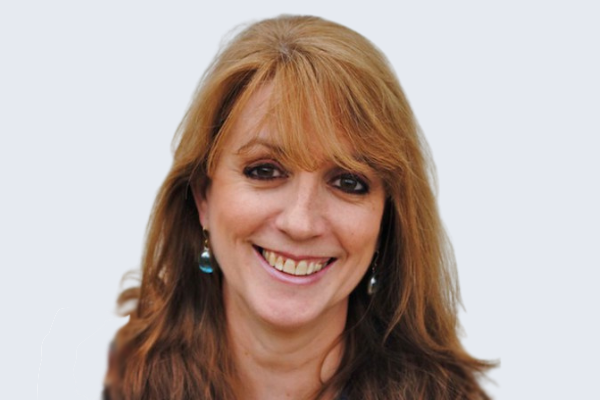Linda Greensmith first arrived at UCL in the 1980s as an undergraduate in the Department of Physiology. Now she’s a professor and Head of the Department of Neuromuscular Diseases.
She has spent her career trying to understand why motor neurones die in MND. Today she leads a large team of scientists at the Graham Watts Laboratories at UCL.
“MND is such a dreadful disease, and such a complex disease that there’s always another question to ask,” she says, “But it really does feel like we are now on the cusp of big change.”
An early fascination
I remember doing O-Levels and despite encouragement of my teachers I was adamant that I didn’t want to be a doctor. But I was quite good at science, and I was fascinated by the human body, I even took an extra O-Level in human physiology.
There were fewer women in science back then. But I wanted to know how the body worked and followed that instinct, enrolling on a degree in Physiology at UCL.
After taking a year away from studying after my degree, working as a medical technician, I went back to do a PhD in developmental neuroscience – and that became my specialism.
It was curiosity that led me there and has motivated me throughout my career. And it was curiosity during my PhD that led me to working on motor neurones.
New beginnings
That curiosity fuelled my years as a postdoctoral researcher, firstly investigating why motor neurones survive during development, and led onto a Wellcome Trust Fellowship to expand my work in molecular biology and start to ask why motor neurons died in MND.
During this Fellowship, I was asked to interview for the Graham Watts Senior Research Fellowship based at the Institute of Neurology. It was an incredible, career-changing opportunity. The offer of the position coincided perfectly with the birth of my third (and last!) child, and I took up the post after returning from maternity leave in April 1999.
So there I was, raising three young children, and taking on this huge task setting up these laboratories – but it was absolutely worth it.
I moved from the Medical School at UCL to the Institute of Neurology, and I’ve been here ever since – where I am now the Head of the recently established Department of Neuromuscular Diseases. We have a large, world class group of MND researchers– and it really does feel like we are on the cusp of big change.
The power of patience
Our research has also expanded beyond MND, to other neuromuscular disorders, because we realised that many of the mechanisms we were looking at were clearly applicable to other diseases.
Kennedy’s Disease, for example, is a rare disorder of the motor neurones caused by a genetic mutation, and like MND, results in motor neurone death and muscle weakness and atrophy. Our research into Kennedy’s Disease has grown significantly over the last few years and we are now one of very few groups working on this particular disorder.
One of our long-term projects has focused on the therapeutic potential of a novel drug called Arimoclomol. The drug is widely applicable to many diseases, including MND and Kennedy’s Disease.
In each of these diseases, proteins in the nerve cells are incorrectly processed – a situation we call protein mishandling or protein misfolding. This can lead to an accumulation of abnormal proteins, which can seriously damage or kill cells.
Arimoclomol is now in trials for a number of protein misfolding disorders, including the muscle-wasting condition, inclusion body myositis. It’s also in trials for MND. Research into Arimoclomol has now moved into clinical trials and human testing. We don’t know the outcome of this yet – and as a scientist I’m always cautious until I see the final results – but the fact we’ve reached this stage is incredible.
It’s an exciting time to be working in this field. We understand MND today so much more now than we did when I set up the labs. For example, we’re really starting to realise that MND is likely to be part of a disease spectrum, and that we need to focus on the underlying processes rather than the clinical symptoms. I think that’s key to identifying a disease modifying therapy for such a complex disorder as MND.
Nurturing the next generation
As Head of Department, I don’t get the lab time I used to. But my team is doing amazing collaborative work. We have about 15 people in the lab at the moment and because of our links to the hospital, we get to work alongside and train clinical scientists too, so there’s a really excellent collaborative spirit.
We meet up weekly as a group to discuss the work and it’s so exciting when the students come to see me with their results. That’s when you know that all that hard work, that frustration – it’s all paid off. For the students, right at the beginning of their careers, they’re seeing for the first time the real impact their research could have on the lives of people with MND – and that’s really special.
Training new scientists has been an important part of my job since day one – this has been a goal of my Fellowship. So, it makes me really proud to think that I’ve now trained over 30 PhD students in the lab as a primary supervisor.
It’s not all about the science
I’m so proud of what we’ve achieved over the last 20 years. Research has been such a big part of my life. But as I said, I became the Graham Watts Fellow in 1999 when my youngest daughter was born, so there’s always been a balance of family and science.
My three daughters are all grown up now. The eldest is 28 and she’s just finished her PhD in neuroscience. I’ve tried to not to influence her, and to let her follow her own path. I’m not sure whether she’ll stay in the lab, but I know she’ll make the right choices for her.
My second daughter is in Sydney, living on Bondi Beach and designing playgrounds for children. It’s very creative and I’m chuffed to see her having such a wonderful time.
And then my youngest is still at university doing a degree in architectural engineering. She’s about to start her year in industry so I’m really excited for her. They’ve all taken such interesting routes and can’t wait to see where life takes them.
To think how small they were when I was setting up the labs in 1999 reminds me just how much time has passed – and how far we’ve all come.
And the MND Association has been fundamental to the success of my group. So much of our research simply wouldn’t have happened without their funding. Now it feels like we’re really close to making a major impact on this disease. We’ve built up so much knowledge – and so the contribution you’re making today could be more effective now than it ever has been.

